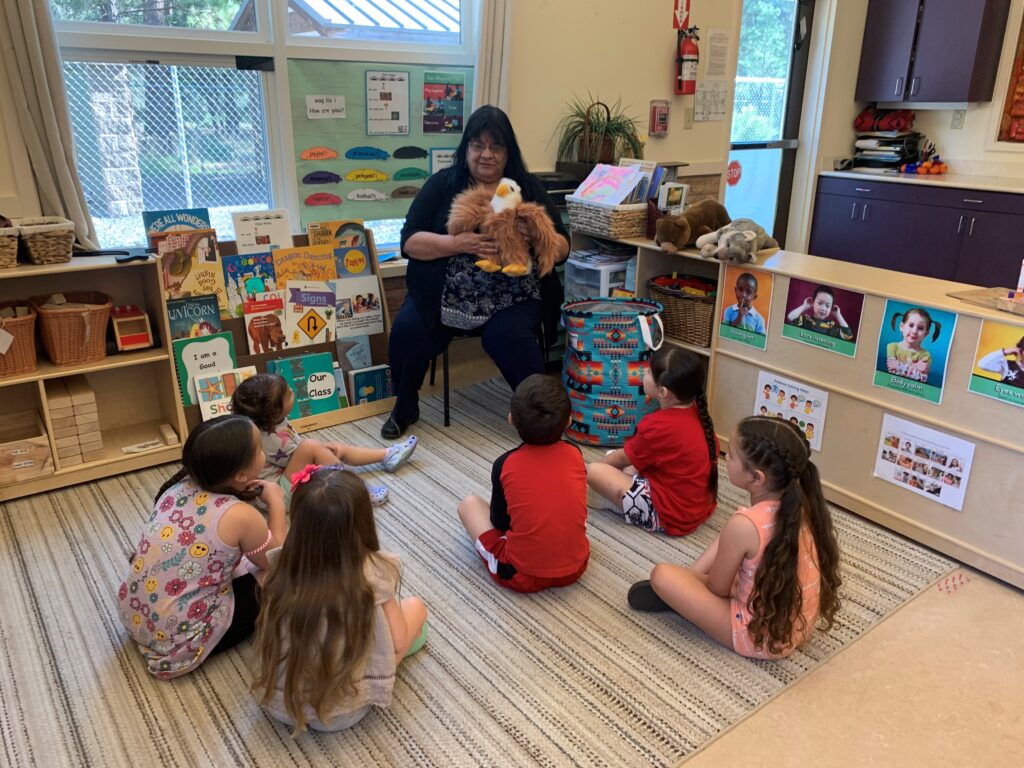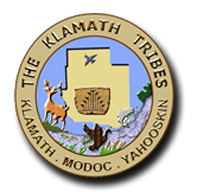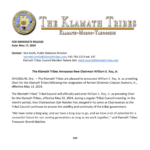FOR IMMEDIATE RELEASE
Date: May 30, 2023
Contact: Ken Smith, Public Relations Director
kenneth.smith@klamathtribes.com; 541-783-2219 ext. 147
Jennifer Jackson, Early Childhood Development Center Director,
jennifer.jackson@klamathtribes.com
Early Childhood Klamath Language Immersion Program Educates Next Generation of Speakers
CHILOQUIN, Ore. — In an effort to preserve their native language, the Klamath Tribes has introduced an early childhood language immersion program teaching Klamath to children at the tribes’ Early Childhood Development Center (ECDC) in Chiloquin. Revitalizing indigenous languages is an ongoing effort by tribes across the country, and for children to best succeed, lessons should begin at an early age.
The ultimate goal is to develop a generation of fluent Klamath speakers who can then teach their children the language. With only a handful of tribal members who are master speakers, the challenge is all the greater to teach a new generation of fluent Klamath speakers.
Klamath tribal members Jennifer Jackson, the ECDC Director, and Kootsie Cunial, ECDC’s Project Leader, are overseeing the language program. Currently, there are 25 children being taught Klamath at ECDC. The educational center has been open for seven years, and the early childhood language immersion program was introduced two years ago. Other lead teaching staff incorporating the Klamath language into their curriculum include preschool teacher, Terri Lawrence, and Josephine Montoya, an infant/toddler teacher.
Jackson said the immersion language program is taught in all classrooms, starting as young as six weeks of age up to five years.
“As soon as we start immersing them into the language, we start with small words in the classroom,” Jackson said. “So, they understand ‘water’’; they understand ‘please’, and ‘good-bye’. They are small words that they use in their daily tasks, that they’ll use throughout the day. So, the children will begin to understand it before they can start talking.”
When the children reach preschool ages 3-5, Cunial takes over, teaching them more advanced words. She teaches a variety of words that the children will hear daily, develops activities for them to learn new words throughout the day, and two times per day, she provides language-focused classes.
Cunial said it’s important to teach children the Klamath language at a young age. “The younger you introduce the language, the more they are going to understand it, and the more they’re likely to speak it,” she said.
Prior to starting the immersion program, Cunial researched the Klamath language and culture, watched webinars and studied how language was being taught by other tribes throughout the country.
“What I did is used our Klamath year with the cycle of what the Klamath people did at the time, and I integrated some of the Klamath words into the language,” she said. “So, when we have ceremonies or things pertaining to that, then those are the words the kids are learning in the classroom.”
She cited the c’waam ceremony as one example when the children learned words for it during a classroom lesson.
“By starting in preschool, the children learn easily because it’s new to them,” Jackson said, “and it’s a daily part of their lives, and they are also teaching their parents the language as they learn it.”
The children have also displayed their natural inclination to use Klamath during the “Smart Readers” program, which involves teachers from outside coming to the classroom to read to the children. Cunial said that when the children were asked questions by the instructors, they responded in Klamath.
“The last time they were here, they showed a picture of a bear, and the kids said ‘loq’ because they knew it was a ‘loq’,” Cunial said. “And when they come in and said ‘hello’, we had a couple of the kids say ‘waq lis ʔi ‘, which means ‘how are you’. And when they leave, they said ‘oonc’ee, which means, our ‘good-bye’, which is ‘later.’ And they (teachers) pick up on this, and they come and ask the children, ‘Oh, what’s the words for this?’ and our kid’s will respond.”
Cunial said older children who have been in the program for two years are now teaching the younger children words they have learned, such as words for all the colors and vegetables. “They’re not just learning from the teachers, they’re learning from each other,” she said.
With the success of ECDC’s language immersion program, the next step is to introduce more advanced language studies in elementary school. Klamath Tribes Language Director, GeorGene Nelson, is in discussion with the Chiloquin Elementary School to develop a Klamath language program, and Klamath Tribal Member Rachel Belefant, a Chiloquin kindergarten teacher and this year received the Klamath County School District Crystal Apple Award, teaches the Klamath language in her class.
Jackson said the road to mastering the Klamath language is for the young students now learning the language to continue studying it through high school. It’s also important, she said, for families to embrace learning the language and bring it into the home and use it in their daily life.
The Klamath immersion language program is the beginning of the preservation of the language of the indigenous people of the Klamath basin, and the righting of past wrongs, when Native American children were taken to boarding schools from the 50s into the 80s and taught only English, and banned from speaking their native languages.
Tribes across the country are now trying to make up for lost decades of Native language use and studies. “People have really been trying to get their language back,” Cunial said.
“This is the first time we’ve ever had a language department,” added Jackson. “There have been efforts by the Culture and Heritage Department, but now we’re finally breaking it out to having our own language department. I think that’s the first step to when we will see a bigger push to bring the language back.”

Klamath Tribes Early Childhood Development Center Project Leader Kootsie Cunial teaches preschoolers Klamath words as part the language immersion program. (Photo by Ken Smith/Klamath Tribes. Image is available for media use.)





